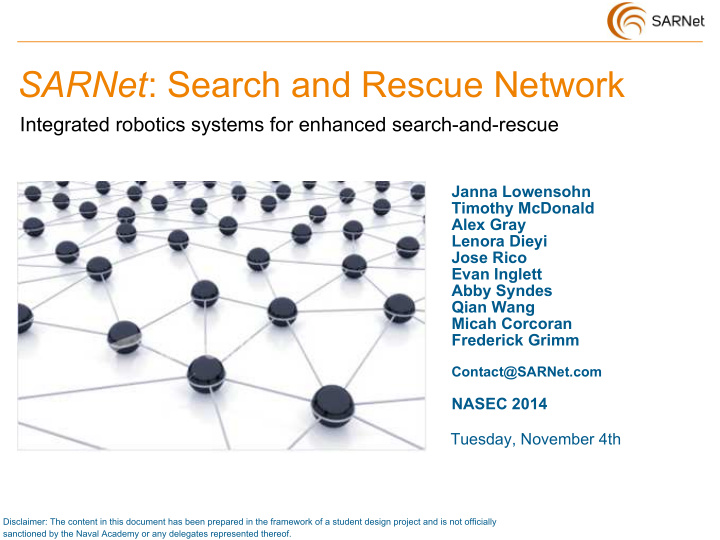



SARNet : Search and Rescue Network Integrated robotics systems for enhanced search-and-rescue Janna Lowensohn Timothy McDonald Alex Gray Lenora Dieyi Jose Rico Evan Inglett Abby Syndes Qian Wang Micah Corcoran Frederick Grimm Contact@SARNet.com NASEC 2014 Tuesday, November 4th Disclaimer: The content in this document has been prepared in the framework of a student design project and is not officially sanctioned by the Naval Academy or any delegates represented thereof.
Existing Implementa Problem Purpose Solution Future Tech tion SARNet will enhance current Search-and-Rescue efforts GOAL: Increase probability of rescue and survival in disaster scenarios PROBLEMS: Non-optimal use of current systems Lack of ability to make medical assessments of victims DELIVERABLES: SARNet System VALUE: Incremental saving of human life 2
Existing Implementa Problem Purpose Solution Future Tech tion Current state faces two main challenges Single Systems/Limited Capacity • Low efficiency • Human operators are required • Systems are not widely used Lack of Medical Assessment • Current systems can’t make initial medical assessment of victims 3
Existing Implementa Problem Purpose Solution Future Tech tion Current state faces two main challenges Single Systems/Limited Capacity • Low efficiency • Human operators are required • Systems are not widely used Lack of Medical Assessment • Current systems can’t make initial medical assessment of victims 4
Existing Implementa Problem Purpose Solution Future Tech tion SARNet to increase survivability in disaster situations Better Make initial management of Effective use of assessment of human, robotic, robotic systems victim and and medical surroundings resources Improvement of victim survivability 5
Existing Implementa Problem Purpose Solution Future Tech tion SARNet to allow for integrated cooperation Cooperation between robotic systems Interactions between Connecting victims humans (victims/ and families post- responders) and disaster robots 6
Existing Implementa Problem Purpose Solution Future Tech tion Existing technologies yield room for improvement ALADDIN • Research team application that uses game theory to decide victim rescue order (Aladdinproject.org) SENEKA, IEEE • Sensor network for mobile robots to communicate during disaster managment Quadcopters and drones • Used for immediate site surveillance and analysis 7
Existing Implementa Problem Purpose Solution Future Tech tion Existing technologies yield room for improvement ALADDIN • Research team application that uses game theory to decide victim rescue order (Aladdinproject.org) SENEKA, IEEE • Sensor network for mobile robots to communicate during disaster managment Quadcopters and drones • Used for immediate site surveillance and analysis 8
Existing Implementa Problem Purpose Solution Future Tech tion Existing technologies yield room for improvement ALADDIN • Research team application that uses game theory to decide victim rescue order (Aladdinproject.org) SENEKA, IEEE • Sensor network for mobile robots to communicate during disaster managment Quadcopters and drones • Used for immediate site surveillance and analysis 9
Existing Implementa Problem Purpose Solution Future Tech tion Solution requires integration of specialized robots into one cooperative system Locate • Seneka robots help in locating people Communicate • Commmunicate with Aladdin robots to help rescue workers determine where help is needed Diagnose • Diagnosis robots take skin temperature, capillary refill, heart rate, images of victims, stress level and report back to radio station Action • Rescue workers know what to do for each victim using diagnosis 10
Existing Implementa Problem Purpose Solution Future Tech tion Solution allows for communication between robotic systems 11
Existing Implementa Problem Purpose Solution Future Tech tion SARNet implementation for two phases 12
Existing Implementa Problem Purpose Solution Future Tech tion Future state will enable additional system efficiencies Funding University grants U.S. Government Fully autonomous system will be independent of human Autonomy interaction Training of workers to implement system necessary for workers Training jobs to accommodate the changing 13
Recommend
More recommend